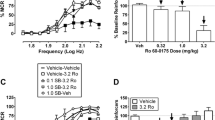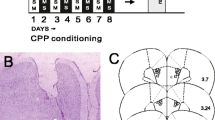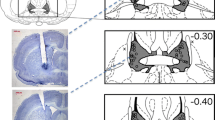Abstract
Rationale
Application of cocaine or exposure to cocaine-related stimuli induces widespread activation of the cortex in neuroimaging studies with human subjects. In accordance to these findings, it was reported in previous microdialysis experiments that cocaine increased serotonin (5-HT) and dopamine in various cortical brain areas. The present series of studies set out to investigate the functional role of the observed increases in 5-HT in the medial prefrontal cortex (mPFC), the entorhinal cortex (EC), and the occipital cortex (OccC) in the mediation of cocaine-induced conditioned place preference (CPP) and hyperactivity.
Materials and methods
To reduce 5-HTergic neurotransmission in circumscribed brain areas, bilateral local infusions of the serotonergic neurotoxin, 5,7-dihydroxytryptamine (5,7-DHT), were made into the mPFC, EC, or OccC. Two weeks following surgery, cocaine-induced (10 mg/kg; i.p.) CPP was measured in an unbiased design.
Results
The 90% depletion of 5-HT in the mPFC significantly attenuated the preference for the cocaine-associated environment and the hyperlocomotor response to cocaine. A 61% depletion of 5-HT in the EC reduced conditioned place preference without modulation of hyperactivity, while a 78% 5-HT depletion of the OccC cortex had no effect on cocaine-induced CPP and hyperactivity. No lesion affected general activity, habituation learning, or visual stimulation-induced behavioral activation.
Conclusion
These results indicate an important role of cortical 5-HT in the mediation of cocaine-induced CPP and specify the region-dependent contribution of a neurochemical response to cocaine-mediated behavior.





Similar content being viewed by others
References
Aronson SC, Black JE, McDougle CJ, Scanley BE, Jatlow P, Kosten TR, Heninger GR, Price LH (1995) Serotonergic mechanisms of cocaine effects in humans. Psychopharmacology 119:179–185
Baumgarten HG, Lachenmayer L (2004) Serotonin neurotoxins—past and present. Neurotox Res 6:589–614
Biegon A, Samuel D (1979) The in vivo distribution of an antidepressant drug (DMI) in male and female rats. Psychopharmacology (Berl) 65:259–263
Bortolozzi A, Díaz-Mataix L, Scorza MC, Celada P, Artigas F (2005) The activation of 5-HT2A receptors in prefrontal cortex enhances dopaminergic activity. J Neurochem 95:1597–1607
Breiter HC, Gollub RL, Weisskoff RM, Kennedy DN, Makris N, Derke JD, Goodman JM, Kantor HL, Gastfriend DR, Riorden JP, Mathew RT, Rosen BR, Hyman SE (1997) Acute effects of cocaine on human brain activity and emotion. Neuron 19:591–611
Carey RJ, Damianopoulos E (1994) Conditioned cocaine induced hyperactivity: an association with increased medial prefrontal cortex serotonin. Behav Brain Res 62:177–185
De Souza Silva MA, Mattern C, Häcker R, Nogureia PJ, Huston JP, Schwarting RK (1997) Intranasal administration of the dopaminergic agonists L-DOPA, amphetamine, and cocaine increases dopamine activity in the neostriatum: a microdialysis study in the rat. J Neurochem 68:233–239
Devonshire IM, Mayhew JEW, Overton PG (2007) Cocaine preferentially enhances sensory processing in the upper layer of the primary sensory cortex. Neuroscience 146:841–851
Di Ciano P, Everitt BJ (2004) Conditioned reinforcing properties of stimuli paired with self-administered cocaine, heroin or sucrose: implications for the persistence of addictive behaviour. Neuropharmacology 47:202–213
Díaz-Mataix L, Scorza MC, Bortolozzi A, Toth M, Celada P, Artigas F (2005) Involvement of 5-HT1A receptors in prefrontal cortex in the modulation of dopaminergic activity: role in atypical antipsychotic action. J Neurosci 25:10831–10843
Dolcos F, LaBar KS, Cabeza R (2004) Interaction between the amygdala and the medial temporal lobe memory system predicts better memory for emotional events. Neuron 42:855–863
Eichenbaum H (2000) A cortical–hippocampal system for declarative memory. Nat Rev Neurosci 1:41–50
Everitt BJ, Robbins TW (2005) Neural systems of reinforcement for drug addiction: from actions to habits to compulsion. Nat Neurosci 8:1481–1489
Filip M, Cunningham KA (2003) Hyperlocomotive and discriminative stimulus effects of cocaine are under the control of serotonin2C (5-HT2C) receptors in rat prefrontal cortex. J Pharmacol Exp Ther 306:734–743
Grant S, London ED, Newlin DB, Villemagne VL, Liu X, Contoreggi C, Phillips RL, Kimes AS, Margolin A (1996) Activation of memory circuits during cue-elicited cocaine craving. Proc Natl Acad Sci USA 93:12040–12045
Harris GC, Aston-Jones G (2003) Critical role for ventral tegmental glutamate in preference for a cocaine-conditioned environment. Neuropsychopharmacology 28:73–76
Hemby SE, Jones GH, Neill DB, Justice JB (1992) 6-Hydroxydopamine lesions of the medial prefrontal cortex fail to influence cocaine-induced place conditioning. Behav Brain Res 49:225–230
Herges S, Taylor DA (1999) Modulation of cocaine-induced locomotor activity, rears and head bobs by application of WAY100635 into the dorsal and median raphe nuclei of the rat. Naunyn-Schmiedeberg’s Arch Pharmacol 360:129–134
Higgins GA, Fletcher PJ (2003) Serotonin and drug reward: focus on 5-HT2C receptors. Eur J Pharmacol 480:151–162
Homberg JR, De Boer SF, Raaso HS, Olivier JD, Verheul M, Ronken E, Cools AR, Ellenbroek BA, Schoffelmeer AN, Vanderschuren LJ, De Vries TJ, Cuppen E (2008) Adaptations in pre- and postsynaptic 5-HT(1A) receptor function and cocaine supersensitivity in serotonin transporter knockout rats. Psychopharmacology (Berl) (in press) doi:10.1007/s00213-008-1212-x
Hyman SE (2005) Addiction: a disease of learning and memory. Am J Psychiatry 162:1414–1422
Jocham G, Lezoch K, Müller CP, Kart-Teke E, Huston JP, de Souza Silva MA (2006) Neurokinin3 receptor antagonism attenuates cocaine’s behavioural activating effects yet potentiates its dopamine- enhancing action in the nucleus accumbens core. Eur J Neurosci 24:1721–1732
Jocham G, Lauber AC, Müller CP, Huston JP, De Souza Silva MA (2007) Neurokinin 3 receptor activation potentiates the psychomotor and nucleus accumbens dopamine response to cocaine, but not its place conditioning effects. Eur J Neurosci 25:2457–2472
Kalivas PW (2005) How do we determine which drug-induced neuroplastic changes are important? Nat Neurosci 8:1440–1441
Kalivas PW, Volkow ND (2005) The neural basis of addiction: a pathology of motivation and choice. Am J Psychiatry 162:1403–1413
Kelly AE (2004) Memory and addiction: shared neural circuitry and molecular mechanisms. Neuron 41:161–179
Kempf E, Mack G, Canguilhem B, Mandel P (1978) Seasonal changes in the levels and the turnover of brain serotonin and noradrenaline in the European hamster kept under constant environment. Experientia 34:1032–1033
Koob GF, Sanna PP, Bloom FE (1998) Neuroscience of addiction. Neuron 21:467–476
Kosten TR, Scanley BE, Tucker KA, Oliveto A, Prince C, Sinha R, Potenza MN, Skudlarski P, Wexler BE (2006) Cue-induced brain activity changes and relapse in cocaine-dependent patients. Neuropsychopharmacology 31:644–650
LaBar KS, Cabeza R (2006) Cognitive neuroscience of emotional memory. Nat Rev Neurosci 7:54–64
Loh EA, Roberts DCS (1990) Break-points on a progressive ration schedule of reinforcement by intravenous cocaine increases following depletion of forebrain serotonin. Psychopharmacology 101:262–266
Morrow BA, Roth RH (1996) Serotonergic lesions alter cocaine-induced locomotor behavior and stress-activation of the mesocorticolimbic dopamine system. Synapse 23:174–181
Müller CP, Huston JP (2006) Determining the region-specific contributions of 5-HT receptors to the psychostimulant effects of cocaine. Trends Pharmacol Sci 27:105–112
Müller CP, Huston JP (2007) Dopamine activity in the occipital and temporal cortices of rats: dissociating effects of sensory but not pharmacological stimulation. Synapse 61:254–258
Müller CP, Carey RJ, Huston JP, De Souza Silva MA (2007a) Serotonin and psychostimulant addiction: focus on 5-HT1A-receptors. Prog Neurobiol 81:133–178
Müller CP, De Souza Silva MA, Huston JP (2007b) Double dissociating effects of sensory stimulation and cocaine on serotonin activity in the occipital and temporal cortex. Neuropharmacology 52:854–862
Paxinos G, Watson C (1986) The Rat Brain in Stereotactic Coordinates. Academic Press, New York
Pehek EA, Nocjar C, Roth BL, Byrd TA, Mabrouk OS (2006) Evidence for the preferential involvement of 5-HT2A serotonin receptors in stress- and drug-induced dopamine release in the rat medial prefrontal cortex. Neuropsychopharmacology 31:265–277
Pierce RC, Reeder DC, Hicks J, Morgan ZR, Kalivas PW (1998) Ibotenic acid lesions of the dorsal prefrontal cortex disrupt the expression of behavioral sensitization to cocaine. Neuroscience 82:1103–1114
Pum ME, Carey RJ, Huston JP, Müller CP (2007) Dissociating effects of cocaine and d-amphetamine on dopamine and serotonin in the perirhinal, entorhinal, and prefrontal cortex of freely moving rats. Psychopharmacology 193:375–390
Pum ME, Huston JP, De Souza Silva MA, Müller CP (2008) Visual sensory-motor gating by serotonin-activation in the medial prefrontal and occipital, but not in the rhinal, cortices in rats. Neuroscience 153:361–372
Ramsey PH (1993) Multiple comparisons of independent means. In: Edwards LK (ed) Applied analysis of variance in behavioral science. Marcel Dekker, New York, pp 25–61
Roberts DC, Loh EA, Baker GB, Vickers G (1994) Lesions of central serotonin systems affect responding on a progressive ratio schedule reinforced either by intravenous cocaine or by food. Pharmacol Biochem Behav 49:177–182
Rocha BA (2003) Stimulant and reinforcing effects of cocaine in monoamine transporter knockout mice. Eur J Pharmacol 479:107–115
Roesler R, Roozendaal B, McGaugh JL (2002) Basolateral amygdala lesions block the memory-enhancing effect of 8-Br-cAMP infused into the entorhinal cortex of rats after training. Eur J Neurosci 15:905–910
Satel SL, Krystal JH, Delgado PL, Kosten TR, Chraney DS (1995) Tryptophan depletion and attenuation of cue-induced craving for cocaine. Am J Psychiatry 152:778–783
See RE (2005) Neural substrates of cocaine-cue associations that trigger relapse. Eur J Pharmacol 526:140–146
Szumlinski KK, Price KL, Frys KA, Middaugh LD (2002) Unconditioned and conditioned factors contribute to the ‘reinstatement’ of cocaine place conditioning following extinction in C57BL/6 mice. Behav Brain Res 136:151–160
Szumlinski KK, Frys KA, Kalivas PW (2004) Dissociable roles for the dorsal and median raphé in the facilitatory effect of the 5-HT1A receptor stimulation upon cocaine-induced locomotion and sensitization. Neuropsychopharmacology 29:1675–1687
Thiel CM, Müller CP, Huston JP, Schwarting RK (1999) High versus low reactivity to a novel environment: behavioural, pharmacological and neurochemical assessments. Neuroscience 93:243–251
Tran-Nguyen LTL, Bellew JG, Grote KA, Neisewander JL (2001) Serotonin depletion attenuates cocaine-seeking but enhances sucrose seeking and the effects of cocaine priming on reinstatement of cocaine seeking in rats. Psychopharmacology 157:340–348
Tzschentke TM (2007) Measuring reward with the conditioned place preference (CPP) paradigm: update of the last decade. Addict Biol 12:227–462
Tzschentke TM, Schmidt WJ (1999) Functional heterogeneity of the rat medial prefrontal cortex: effects of discrete subarea-specific lesions on drug-induced conditioned place preference and behavioural sensitization. Eur J Neurosci 11:4099–4109
Tzschentke TM, Schmidt WJ (2000) Differential effects of discrete subarea-specific lesions of the rat medial prefrontal cortex on amphetamine- and cocaine-induced behavioural sensitization. Cereb Cortex 10:488–498
Valzelli L, Bernasconi S, Cusumano G (1977) Annual and daily changes in brain serotonin content in differentially housed mice. Neuropsychobiology 3:35–41
Van der Plasse G, La Fors SSBM, Meerkerk DTJ, Joosten RNJMA, Uylings HBM, Feenstra MGP (2007) Medial prefrontal cortex serotonin in the rat is involved in goal-directed behaviour when affects guides decision making. Psychopharmacology 195:435–449
Ventura R, Morrone C, Puglisi-Allegra S (2007) Prefrontal/accumbal catecholamine system determines motivational salience attribution to both reward- and aversion-related stimuli. Proc Natl Acad Sci USA 104:5181–5186
Vertes RP (1991) A PHA-L analysis of ascending projections of the dorsal raphe nucleus in the rat. J Comp Neurol 313:643–668
Wise RA (2002) Brain reward circuitry: insights form unsensed incentives. Neuron 36:229–240
Zalava AR, Weber SM, Rice HJ, Alleweireldt AT, Neisewander JL (2003) Role of the prelimbic cortex in acquisition, extinction, and reinstatement of cocaine-conditioned place preference. Brain Res 990:157–164
Zernig G, Ahmed SH, Cardinal RN, Morgan D, Acquas E, Foltin RW, Vezina P, Negus SS, Crespo JA, Stöckl P, Grubinger P, Madlung E, Haring C, Kurz M, Saria A (2007) Explaining the escalation of drug use in substance dependence. Pharmacology 80:65–119
Acknowledgement
This work was supported by the research grant HU306/23-5 from the Deutsche Forschungsgemeinschaft, a NIDA grant DA R01 DA 05366-17, and a VA Merit Review grant.
Author information
Authors and Affiliations
Corresponding author
Rights and permissions
About this article
Cite this article
Pum, M.E., Carey, R.J., Huston, J.P. et al. Role of medial prefrontal, entorhinal, and occipital 5-HT in cocaine-induced place preference and hyperlocomotion: evidence for multiple dissociations. Psychopharmacology 201, 391–403 (2008). https://doi.org/10.1007/s00213-008-1296-3
Received:
Accepted:
Published:
Issue Date:
DOI: https://doi.org/10.1007/s00213-008-1296-3




